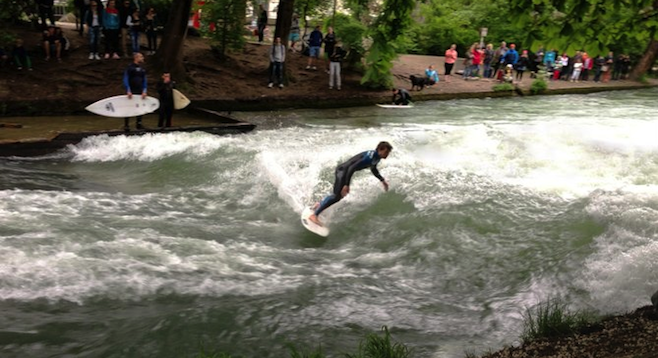 Facebook
Facebook
 X
X
 Instagram
Instagram
 TikTok
TikTok
 Youtube
Youtube

Sitting near the base of the Alps in southern Germany, Münich's nearest coastline would be where Venice slowly sinks into the Adriatic some 300 miles away. But while one might make the case a gondolier could do well on a stand-up paddleboard, there's no surf in Venice. There is, however, in Münich.
In fact, while San Diego's Pacific shoreline is all too prone to flat days, on Münich's tiny Eisbach river, the surf's been up just about every day for the past 40 years, other than a few times the river's frozen over.
The name Eisbach translates directly to "ice brook." It's a manmade tributary of the larger Isar river, whose frigid waters originate in the snowy Bavarian Alps. Isar means "fast water," and that speedy flow helps support a waist-high standing wave where the Eisbach rushes out from a pressurized underground section at Prinzregentenstraße ("Prince Regent Street"), directly below the Haus der Kunst art museum, on the south border of the Englischer Garten.
Munich's so-called "English Garden" easily surpasses Manhattan's Central Park in size, extending out from the center of town for miles to the northeast, where it eventually dissipates into the farmland supplying wheat, barley and hops for the vast amounts of German beer the world craves. Beer production might be the only thing Münich and San Diego have in common, were it not for surfing.
Wood planks chained to the Prinzregentenstraße bridge give the wave its shape – basically a soft section of wall roughly 30 feet across. Surfers stand in line on either bank, taking turns dropping in on the wave, much like skateboarders on a half-pipe.
Each surfer gets to cut back and forth across the wave until falling in, though if others are waiting the etiquette seems to dictate no more than a minute or so. Consequently, regulars spend much of their turns practicing tricks, particularly 360 spins, shove-its and other skater-inspired moves.
With the popular museum so close, crowds inevitably gather to watch the river surfers do their thing, and many of the guys and gals respond with a bit of showmanship, like performing their tricks on broken boards or wearing a fedora.
One can't help wonder whether these riders could hack it on our own local waves. While they presumably lack basic skills such as paddling out, duck-diving or even popping up, they certainly do have some moves. More importantly, they clearly have enough passion that even an obstacle as seemingly insurmountable as geography hasn't stopped them from surfing.


Sitting near the base of the Alps in southern Germany, Münich's nearest coastline would be where Venice slowly sinks into the Adriatic some 300 miles away. But while one might make the case a gondolier could do well on a stand-up paddleboard, there's no surf in Venice. There is, however, in Münich.
In fact, while San Diego's Pacific shoreline is all too prone to flat days, on Münich's tiny Eisbach river, the surf's been up just about every day for the past 40 years, other than a few times the river's frozen over.
The name Eisbach translates directly to "ice brook." It's a manmade tributary of the larger Isar river, whose frigid waters originate in the snowy Bavarian Alps. Isar means "fast water," and that speedy flow helps support a waist-high standing wave where the Eisbach rushes out from a pressurized underground section at Prinzregentenstraße ("Prince Regent Street"), directly below the Haus der Kunst art museum, on the south border of the Englischer Garten.
Munich's so-called "English Garden" easily surpasses Manhattan's Central Park in size, extending out from the center of town for miles to the northeast, where it eventually dissipates into the farmland supplying wheat, barley and hops for the vast amounts of German beer the world craves. Beer production might be the only thing Münich and San Diego have in common, were it not for surfing.
Wood planks chained to the Prinzregentenstraße bridge give the wave its shape – basically a soft section of wall roughly 30 feet across. Surfers stand in line on either bank, taking turns dropping in on the wave, much like skateboarders on a half-pipe.
Each surfer gets to cut back and forth across the wave until falling in, though if others are waiting the etiquette seems to dictate no more than a minute or so. Consequently, regulars spend much of their turns practicing tricks, particularly 360 spins, shove-its and other skater-inspired moves.
With the popular museum so close, crowds inevitably gather to watch the river surfers do their thing, and many of the guys and gals respond with a bit of showmanship, like performing their tricks on broken boards or wearing a fedora.
One can't help wonder whether these riders could hack it on our own local waves. While they presumably lack basic skills such as paddling out, duck-diving or even popping up, they certainly do have some moves. More importantly, they clearly have enough passion that even an obstacle as seemingly insurmountable as geography hasn't stopped them from surfing.
Comments